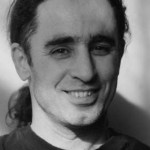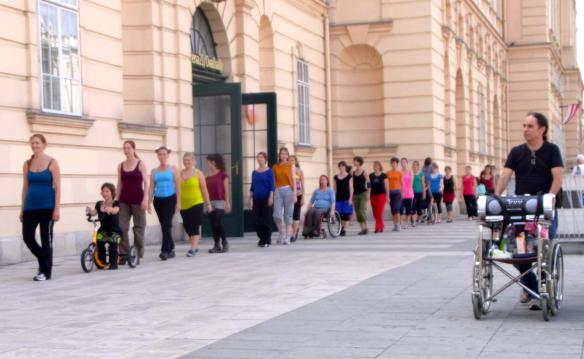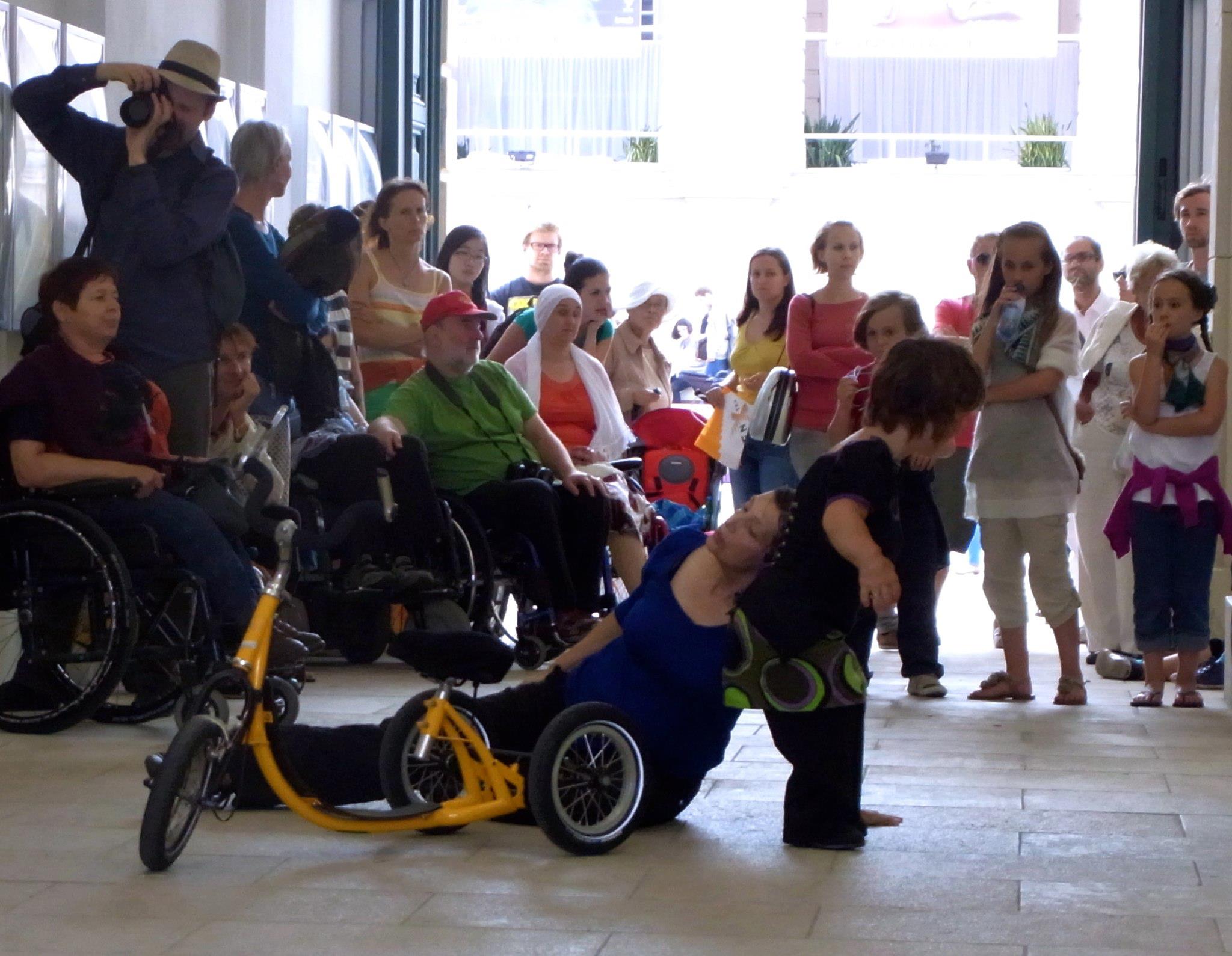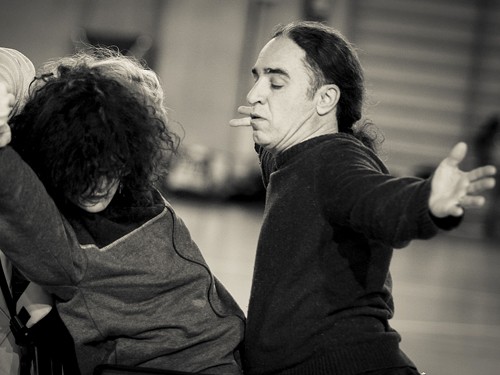Alito Alessi: Beyond “Us” versus “Them”
An Interview with Alito Alessi, Part Two
BY EMMALY WIEDERHOLT
Alito Alessi is the artistic director of DanceAbility® International and co-founder of DanceAbility®. He is internationally known as a pioneering teacher and choreographer in the fields of contact improvisation, dance and disability. This is part two of a two-part interview, in which he discusses ideas behind performance platforms and the broader impact of his work.
I understand that in addition to your work in DanceAbility, you’ve mounted a fair number of street parades. Can you talk a little more about the goals and motivations behind them?
We call them a lot of things — street parades, urban interventions, site specific work. I’m a choreographer; I believe in making dance. I believe it’s a powerful tool for opening the various senses of perception for people to see and experience something they’ve never seen or experienced before, in which people have already determined a pre-mindset or series of assumptions about something or somebody. It’s an incredible organic resource for teaching. You get people who are just driving in the street or walking at the shopping mall, and most of them think they already know something about the world of difference. They formulate who other people are in relation to themselves. There’s a lot of “us” and “them” that goes on. As a choreographer, I’m really interested in dissolving the “us” and “them” scenario. One of the ways I’ve found to dissolve that is through these events where people by chance come upon something they’ve never imagined and are caught up in an experience that makes them feel something totally different from what their assumptions have taught them to feel. Then boom — in an instant, things change.
I don’t really want to change people. I want to allow people to make changes for themselves should they desire. I try to give an experience that allows for that. I’m not a missionary, trying to make people better or the world better. I believe the world is good enough as it is and people are fine as they are. But I do believe in sharing an experience and seeing what happens.
There are a lot of theaters in the world people cannot get into, for many reasons. You could say architecture for one, but you could say economics for another. There’s a lot of things that leave the world of theater and dance inaccessible to people. I feel like it’s my responsibility to take my work to them. I don’t ask anything from them. They’re just walking or driving or on a bus, and they get entertained.
It’s a powerful teaching tool as well as marketing tool to let people know this kind of work is happening and you too could be involved should you be interested.
Looking back on your 30 years of experience working with inclusivity in dance, which often is a very exclusive art form, what sorts of impact or shifts in attitude have you seen?
Let’s talk from two different perspectives: one from an able-bodied person coming into this work and the other from a person with a disability coming into this work.
This is a general statement, but most able-bodied people come into this work with a disabled perspective. They think they will be helpful or they don’t have something to learn, and they get their minds and bodies absolutely blown away, just because of the experience. It’s often described as a euphoric experience in which you find yourself able to work because the atmosphere is so fresh and new. You get out of your own particular habits of movement which eventually put you to sleep rather than wake you up. People often learn to move their bodies really well but not feel their bodies at all. That doesn’t mean anything to me. I want people to experience that which their bodies are expressing, and that’s what many people get out of this training. They come as a technical contemporary dancer and they don’t realize that through the method they can learn to embody rather than manufacture movement. People come from the dance world and remember the reasons they started dancing in the first place.
Disabled people often come in thinking they need to be more like the able-bodied people. Everybody comes with their own prejudices and assumptions. Sometimes a disabled dancer comes in thinking a “real” dancer wouldn’t accept their movement. So on both levels you learn to accept yourself and other people as they are, which can only be a benefit.
One of the things that happened to me in my life that continuously gets reinforced but was not part of my original intention is that I grew up with three people in my family who were disabled. However, it wasn’t until years after my mother died that I used the description, “I had a disabled mother.” She was just my mother. Period. DanceAbility gets this immense credit for seeing people as people, but it’s kind of a joke. Wow, what a brilliant concept, realizing every person has a body, every body speaks a language, every expression is needed to evolve the planet in a positive direction, and every form of language is necessary to educate different people. It’s sort of a baseline truth but gets lost in the magnitude of today’s world. DanceAbility gets back to what I consider to be a basic truth about movement: movement was the predecessor to language, and since language complicates a lot of things, let’s get back to movement. Let’s have an experience, have a lot of trials and errors, and then organize it into something that can be taught to see people in the present moment. Every movement is valuable.
~~
 Alito Alessi is the artistic director of DanceAbility® International and co-founder of DanceAbility®. He is internationally known as a pioneering teacher and choreographer in the fields of contact improvisation, dance and disability. Alito was selected as a Fulbright Senior Specialist (2007), received the Hong Kong Choreographer of the Year Award (2006), a Guggenheim Fellowship (2005), Choreographer’s Fellowships from the American National Endowment for the Arts (1992-1993 & 1995-1996) and from the Oregon Arts Commission (1991). Alito began training teachers in DanceAbility in 1997. He also teaches educators in various disciplines how to make their classes more accessible. Since 1995, Alito has performed in schools for tens of thousands of children with a dance partner in a wheelchair. Another unique way he reaches broad audiences is with his “Street Performance Parades.” These publicly-sited performances with people with and without disabilities have been performed in many other locations around the world including Eugene, Europe, Brazil and Hong Kong. Alito has overseen the production of three documentaries of his work: “Common Ground,” a video of a DanceAbility workshop; “All Bodies Speak,” showing performance pieces with disabled & non-disabled performers; and “Joy Lab Research,” a documentary of rehearsals and performances on-stage and in a Street Parade in São Paulo, Brazil. He is currently authoring a book, “The DanceAbility Method: Connecting People of all Abilities.”
Alito Alessi is the artistic director of DanceAbility® International and co-founder of DanceAbility®. He is internationally known as a pioneering teacher and choreographer in the fields of contact improvisation, dance and disability. Alito was selected as a Fulbright Senior Specialist (2007), received the Hong Kong Choreographer of the Year Award (2006), a Guggenheim Fellowship (2005), Choreographer’s Fellowships from the American National Endowment for the Arts (1992-1993 & 1995-1996) and from the Oregon Arts Commission (1991). Alito began training teachers in DanceAbility in 1997. He also teaches educators in various disciplines how to make their classes more accessible. Since 1995, Alito has performed in schools for tens of thousands of children with a dance partner in a wheelchair. Another unique way he reaches broad audiences is with his “Street Performance Parades.” These publicly-sited performances with people with and without disabilities have been performed in many other locations around the world including Eugene, Europe, Brazil and Hong Kong. Alito has overseen the production of three documentaries of his work: “Common Ground,” a video of a DanceAbility workshop; “All Bodies Speak,” showing performance pieces with disabled & non-disabled performers; and “Joy Lab Research,” a documentary of rehearsals and performances on-stage and in a Street Parade in São Paulo, Brazil. He is currently authoring a book, “The DanceAbility Method: Connecting People of all Abilities.”



